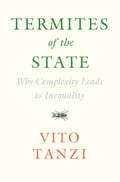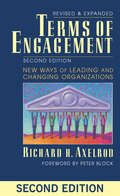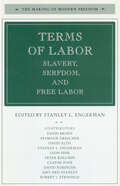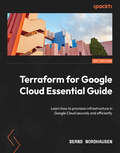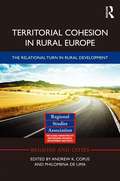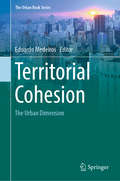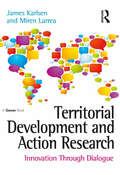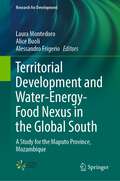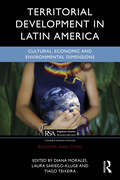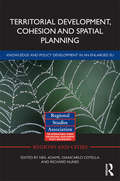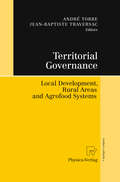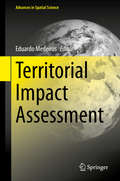- Table View
- List View
Term Sheet Negotiations for Trendsetter, Inc.
by William J. Coughlin Walter KuemmerleDescribes two aspiring entrepreneurs who have just received offering documents for venture funding (known as term sheets) from two venture capital firms. Neither of the entrepreneurs have experience in raising capital and they are wondering how to compare the two proposals and which one to choose. They need to make a decision fast. The documents contain two complete term sheets which are similar in structure but different in important ways. Both term sheets have advantages and disadvantages for the entrepreneurs. Choosing one over the other requires a careful analysis as well as a certain set of assumptions about the growth of Trendsetter, Inc.
Termites and Sustainable Management: Volume 1 - Biology, Social Behaviour and Economic Importance (Sustainability in Plant and Crop Protection)
by Md. Aslam Khan Wasim AhmadThis Volume comprises 12 chapters in an attempt to bring available information on biology, social behavour and economic importance of termites. Chapters in this book dealing with termites identification provide a review on most updated information of their systematics. Ecologically, termites interact with living and non-living surroundings and deliver a wide range of behaviors. In a separate chapter termites ecology is examined and explored. Termites depend on their gut microbes for digestion of complex polysaccharides of wood into simpler molecules. Information provided on termite gut microbiome and lignocellulose degradation constitutes an important contribution. Termite biology and social behaviour have been addressed comprehensively. Trail pheromones are responsible for the orientation and recruitment of nestmates to the food sources. Once arriving at a potential food source, termites assess its quality using a different set of cues. A separate chapter on trail pheromones, cues used during foraging and food assessment, with preferences for foraging sites, contributes a wealth of information. Emphasis has been given on reviewing ecological benefits of termites in other chapters. The information with respect to termite species as an edible insect and the overall role it plays in food and nutrition security in Africa is quite informative. A separate chapter dealing with importance of termites and termitaria in mineral exploration constitutes a significant step in addressing the economic importance of this insect group.
Termites of the State: Why Complexity Leads to Inequality
by Vito TanziIn Termites of the State, renowned public economist Vito Tanzi presents a sweeping account of the industrialized world's economic development during the 20th century to today. In the tradition of grand economic histories, Tanzi connects the biggest issues of the modern world including extreme gaps in income distribution; increasing complexity of government actions and regulations; and asymmetry of access to information and to political influence between the elite and the rest of society. Part one covers the growth of state intervention since the early 20th century - a time before income taxes, central banks or social welfare programs. Part two investigates how and why laws and regulations have expanded in industrialized economies. Part three, building from this foundation, explains the forces behind the precipitous rise in global inequality. With a talent for clear, non-technical writing, Tanzi has produced an important book that will be of interest to any instructor, student, or general reader of economics and public policy.
Terms for Endearment: Business, NGOs and Sustainable Development
by Jem BendellBusiness and NGOs are seen by many to be locked in a perpetual war of values and ideologies. What this book demonstrates is that the war has moved on. Many companies are now engaging with their stakeholders – even those with which they have traditionally had antagonistic relationships – as part of their strategies for improved social and environmental performance. With contributions from an outstanding and diverse group of experts from business, consultancy, research institutes, NGOs and academia, Terms for Endearment investigates the how and why of these new collaborations and provides concrete examples of business working with stakeholder pressure for sustainable development. The book forcibly argues the notion of organizations of civil society setting the standards for business behaviour in the 21st century. For those companies that choose not to pursue high standards of social and environmental performance, confrontation with NGOs must be expected, with negative consequences for sales, costs and social capital, i.e. the bottom line. Terms for Endearment therefore presents business with both a threat and opportunity as we move closer to establishing a social basis for global economic activity.
Terms of Engagement: New Ways of Leading and Changing Organizations
by Richard AxelrodNEW EDITION, REVISED AND UPDATED Building engagement is crucial for every organization. But the traditional top-down coercive change management paradigm--in which leaders "light a fire" under employees--actually discourages engagement. Richard Axelrod offers a better way. After debunking six common change management myths, he offers a proven, practical strategy for getting everyone--not just select committees or working groups--enthusiastically committed to organizational transformation. This revised edition features new interviews--everyone from the vice president of global citizenship at Cirque du Soleil to a Best Buy clerk--and new neuroscience findings that support Axelrod's model. It also shows how you can foster engagement through everyday conversations, staff meetings, and work design.
Terms of Labor: Slavery, Serfdom, and Free Labor
by Stanley EngermanThroughout recorded history, labor to produce goods and services has been a central concern of society, and questions surrounding the terms of labor--the arrangements under which labor is made to produce and to divide its product with others--are of great significance for understanding the past and the emergence of the modern world. For long periods, much of the world's labor could be considered under the coercive control of systems of slavery or of serfdom, with relatively few workers laboring under terms of freedom, however defined. Slavery and serfdom were systems that controlled not only the terms of labor, but also the more general issues of political freedom. The nine chapters in this volume deal with the general issues of the causes and consequences of the rise of so-called free labor in Europe, the United States, and the Caribbean over the past four to five centuries, and point to the many complications and paradoxical aspects of this change. The topics covered are European beliefs that rejected the enslavement of other Europeans but permitted the slavery of Africans (David Eltis), British abolitionism and the impact of emancipation in the British West Indies (Seymour Drescher), the consequences of the end of Russian serfdom (Peter Kolchin), the definition and nature of free labor as seen by nineteenth-century American workers (Leon Fink), the effects of changing legal and economic concepts of free labor (Robert J. Steinfeld), the antebellum American use of the metaphor of slavery (David Roediger), female dependent labor in the aftermath of American emancipation (Amy Dru Stanley), the contrast between individual and group actions in attempting to benefit individual laborers (David Brody), and the link between arguments concerning free labor and the actual outcomes for laborers in nineteenth-century America (Clayne Pope).
Terra Nova: A Social Business Trying to Unlock Land Rights for the Urban Poor in Brazil
by Julie Battilana Priscilla Zogbi Marissa Kimsey Ruth CostasBrothers Andr and Daniel Albuquerque founded the company Terra Nova in 2001 to mediate land disputes between poor families illegally living in urban areas and the official landowners-with the aspiration to improve the lives of the poor. A business-led approach to the issue, like Terra Nova's, was innovative and contested amid the widespread belief that land disputes fell solely within the public sector's purview. After struggling to develop a viable business model, the company received support from impact investing firm MOV Investimentos. By 2019, Terra Nova finally broke even and was exploring opportunities for scaling. But its leaders had to decide the right expansion model for the social business.
Terra Nova: The New World After Oil, Cars, and Suburbs
by Eric W. SandersonA look at what the American lifestyle has done to the environment—and how to move toward a better future. In the last century, three powerful forces—oil, cars, and suburbs—buoyed the American dream. Yet now, the quality of life in the United States is declining due to these same three forces. Our dependence on oil is a root cause of wars, recessions, and natural disasters. Cars consume an outsize share of our incomes and force us to squander time in traffic. Meanwhile, expensive, spread-out suburbs devour farmland—and in a vicious cycle, further entrench our reliance on cars and oil. In Terra Nova, conservation ecologist Eric W. Sanderson—the national bestselling author of Mannahatta—offers concrete steps toward a solution. He delves into natural history, architecture, chemistry, and politics, to show how the American relationship to nature has shaped our past, and how it can affect our future. Illustrated throughout with maps, charts, and infographics, Terra Nova demonstrates that it is indeed possible to achieve a better world. &“Sanderson commendably outlines &‘a new way of life . . . designed to sustain American prosperity, health, and freedom for generations to come.&’&” —Publishers Weekly
Terra Viva: My Life in a Biodiversity of Movements
by Vandana Shiva*2023 Nautilus Book Award Gold Medal Winner: Heroic Journeys&“All of us who care about the future of Planet Earth must be grateful to Vandana Shiva.&”—Jane Goodall, UN Messenger of PeaceA powerful new memoir published to coincide with Vandana Shiva&’s 70th birthday.Vandana Shiva has been described in many ways: the &“Gandhi of Grain,&” &“a rock star&” in the battle against GMOs, and &“the most powerful voice&” for people of the developing world. For over four decades she has vociferously advocated for diversity, indigenous knowledge, localization, and real democracy; she has been at the forefront of seed saving, food sovereignty, and connecting the dots between the destruction of nature, the polarization of societies, and indiscriminate corporate greed.In Terra Viva, Dr. Shiva shares her most memorable campaigns, alongside some of the world&’s most celebrated activists and environmentalists, all working toward a livable planet and healthier democracies. For the very first time, she also recounts the stories of her childhood in post-partition India—the influence of the Himalayan forests she roamed; her parents, who saw no difference in the education of boys and girls at a time when this was not the norm; and the Chipko movement, whose women were &“the real custodians of biodiversity-related knowledge.&” Throughout, Shiva&’s pursuit of a unique intellectual path marrying quantum physics with science, technology, and environmental policy will captivate the reader.Terra Viva is a celebration of a remarkable life and a clear-eyed assessment of the challenges we face moving forward—including those revealed by the COVID crisis, the privatization of biotechnology, and the commodification of our biological and natural resources.&“One of the world&’s most prominent radical scientists.&”—The Guardian
TerraCog Global Positioning Systems: Conflict and Communication on Project Aerial
by Michael Beer Sunru YongTerraCog, a successful privately held high-tech firm that develops GPS (global positioning system) and similar products for consumer markets, has recently been caught off-guard by a competitor's new product that makes novel use of satellite imagery. When TerraCog pursues development of a directly competing product, dubbed Aerial, the projected costs threaten to scuttle the project. The key unit managers gather in a pair of contentious meetings that feature anger, blame, and bewilderment, but produce no effective conclusion. At the end of the case it falls to Emma Richardson, a newly-promoted executive vice-president, to push the group toward a go/no-go decision.
TerraCog Global Positioning Systems: Conflict and Communication on Project Aerial
by Michael Beer Sunru YongTerraCog, a successful privately held high-tech firm that develops GPS (global positioning system) and similar products for consumer markets, has recently been caught off-guard by a competitor's new product that makes novel use of satellite imagery. When TerraCog pursues development of a directly competing product, dubbed Aerial, the projected costs threaten to scuttle the project. The key unit managers gather in a pair of contentious meetings that feature anger, blame, and bewilderment, but produce no effective conclusion. At the end of the case it falls to Emma Richardson, a newly-promoted executive vice-president, to push the group toward a go/no-go decision.
TerraPower
by William A. Sahlman Ramana Nanda Joseph B. Lassiter James McQuadeJohn Gilleland, CEO of TerraPower, returned to his office after a lengthy meeting with potential investors. It was October 2012, and TerraPower was in the process of raising a $200M Series C round to finance the ongoing development of its next-generation nuclear reactor. Though early in the fundraising process, Gilleland noted that this most recent conversation was similar to conversations with other interested cleantech growth equity investors. The conversations circled around a common theme: "This is the biggest idea that's ever been presented at our partners' meeting. We love what you're doing, but it's not right for us as an investment." Outside of raising money from typical growth equity and infrastructure funds, Gilleland could partner with a government and/or form a joint venture with an existing nuclear power player. Reliance Industries as an investor in TerraPower could provide an entry point into the fast growing Indian market. At the same time, Gilleland and Gates had talked with China National Nuclear Corp. about a possible cooperation with TerraPower. Whom should Gilleland call next?
TerraPower
by William A. Sahlman Ramana Nanda Joseph B. Lassiter James McQuadeJohn Gilleland, CEO of TerraPower, returned to his office after a lengthy meeting with potential investors. It was October 2012, and TerraPower was in the process of raising a $200M Series C round to finance the ongoing development of its next-generation nuclear reactor. Though early in the fundraising process, Gilleland noted that this most recent conversation was similar to conversations with other interested cleantech growth equity investors. The conversations circled around a common theme: "This is the biggest idea that's ever been presented at our partners' meeting. We love what you're doing, but it's not right for us as an investment." Outside of raising money from typical growth equity and infrastructure funds, Gilleland could partner with a government and/or form a joint venture with an existing nuclear power player. Reliance Industries as an investor in TerraPower could provide an entry point into the fast growing Indian market. At the same time, Gilleland and Gates had talked with China National Nuclear Corp. about a possible cooperation with TerraPower. Whom should Gilleland call next?
TerraPower
by William A. Sahlman Ramana Nanda Joseph B. Lassiter James McquadeJohn Gilleland, CEO of TerraPower, returned to his office after a lengthy meeting with potential investors. It was October 2012, and TerraPower was in the process of raising a $200M Series C round to finance the ongoing development of its next-generation nuclear reactor. Though early in the fundraising process, Gilleland noted that this most recent conversation was similar to conversations with other interested cleantech growth equity investors. The conversations circled around a common theme: "This is the biggest idea that's ever been presented at our partners' meeting. We love what you're doing, but it's not right for us as an investment." Outside of raising money from typical growth equity and infrastructure funds, Gilleland could partner with a government and/or form a joint venture with an existing nuclear power player. Reliance Industries as an investor in TerraPower could provide an entry point into the fast growing Indian market. At the same time, Gilleland and Gates had talked with China National Nuclear Corp. about a possible cooperation with TerraPower. Whom should Gilleland call next?
Terraform for Google Cloud Essential Guide: Learn how to provision infrastructure in Google Cloud securely and efficiently
by Bernd NordhausenBecome an expert in Terraform on Google Cloud by using Infrastructure as Code for provisioning multiple yet consistent environments to increase productivity in no timeKey FeaturesGet up and running with Terraform on Google CloudLearn Terraform concepts using Google Cloud code examplesApply Terraform to deploy realistic multi-tiered architectures quickly and repeatedlyBook DescriptionGoogle Cloud has adopted Terraform as the standard Infrastructure as Code tool. This necessitates a solid understanding of Terraform for any cloud architect or engineer working on Google Cloud. Yet no specific resources are available that focus on how to use Terraform on Google Cloud. This is the first book that teaches Terraform specifically for Google Cloud. You will take a journey from the basic concepts through to deploying complex architectures using Terraform. Using extensive code examples, you will receive guidance on how to authenticate Terraform in Google Cloud. As you advance, you'll get to grips with all the essential concepts of the Terraform language as applied to Google Cloud and deploy complete working architectures at the push of a button. Finally, you'll also be able to improve your Terraform workflow using Google Cloud native and third-party tools. By the end of this Terraform book, you will have gained a thorough understanding of Terraform and how to use it on Google Cloud, and be able to develop effective Terraform code, build reusable code, and utilize public domain Terraform modules to deploy on Google Cloud faster and more securely.What you will learnAuthenticate Terraform in Google Cloud using multiple methodsWrite efficient Terraform codeUse modules to share Terraform templatesManage multiple environments in Google CloudApply Terraform to deploy multi-tiered architecturesUse public modules to deploy complex architectures quicklyIntegrate Terraform into your Google Cloud environmentWho this book is forThis book is for Google Cloud architects and engineers who want to increase their productivity by using Terraform to automate the provisioning of Google Cloud deployments. A basic understanding of Google Cloud, such as the ability to provision resources using the Google Cloud console and using Cloud Shell, is assumed. Certification in Google Cloud is not required but helpful.
Terrapin Laboratory
by Joseph Fuller Richard G. HamermeshDescribes the formation and rapid growth of a drug testing company. The company needs to decide whether to enter the painkiller testing market, in addition to growing its drug treatment center business. The associated teaching materials provide students the opportunity to weigh the attractiveness of alternative mechanisms for financing the company's expansion.
Terreur Sur Wall Street
by Kenneth EadeL’effondrement du marché boursier a crée un effet d’entraînement dans des proportions désastreuses. Les banques ont échoué, et les gens provoquent des émeutes dans les rues de villes, qui sont en feu. Des pannes localisées ont fait naitre les échecs du système dans son entier. Le professeur d’économie de l’Université de Chicago Harry Mason, Conseiller des président Américains et du Département du Trésor, a rassemblé son équipe de rêve de "jeunes prodiges," les étudiants les plus brillants et diplômés en Economie, pour une classe laboratoire spéciale. Leur mission sauver le monde. Mais est-ce trop tard?
Territorial Cohesion in Rural Europe: The Relational Turn in Rural Development (Regions and Cities)
by Andrew K. Copus Philomena De LimaThis book reflects on how the economies, social characteristics, ways of life and global relationships of rural areas of Europe have changed in recent years. This reveals a need to refresh the concepts we use to understand, measure and describe rural communities and their development potential. This book argues that Europe has 'outgrown' many of the stereotypes usually associated with it, with substantial implications for European Rural Policy. Rural structural change and its evolving geography are portrayed through regional typologies and the concept of the New Rural Economy. Demographic change, migration, business networks and agricultural restructuring are each explored in greater detail. Implications for equality and social exclusion, and recent developments in the field of governance are also considered. Despite being a subject of active debate, interventions in the fields of rural and regional development have failed to adapt to changing realities and have become increasingly polarized. This book argues that rural/regional policy needs to evolve in order to address the current complex reality, partially reformulating territorial or place-based approaches, and the New Rural Paradigm, following a set of principles termed ‘Rural Cohesion Policy’.
Territorial Cohesion: Cohesion, Development, Impact Assessment And Cooperation (Routledge Advances In European Politics Ser.)
by Eduardo MedeirosThis book offers a comprehensive overview of several urban related aspects that are of central importance to successful territorial cohesion processes. In essence, it sheds new light on issues concerning urban polycentrism, functional urban regions, integrated sustainable urban development, and the EU Urban Agenda; and on how they can help to achieve territorial cohesion policy goals. As an elusive and fairly recent concept, territorial cohesion has to date only been vaguely debated in the available literature, which for the most part focuses on its historical origins and its relevance for EU policymaking. Instead, this book synthesizes, for the first time, a range of perspectives that place urban elements and policies at the core of territorial cohesion analysis. As such, and given the fact that territorial cohesion is a holistic concept, the book will appeal to a broad readership from both the academic and policymaking arenas.
Territorial Development and Action Research: Innovation Through Dialogue
by James Karlsen Miren LarreaTerritorial Development and Action Research examines the role of action research within fields such as territorial development and innovation. Most researchers analyse these fields from the outside, developing a theoretical understanding of what should be done, but not of how to do it. Based on their own experience of territorial development processes from the inside out, James Karlsen and Miren Larrea argue that filling the gap regarding social relations in the innovation process makes it possible for researchers to engage in the processes taking place in the territory, thereby revealing how to make things work. This book will help researchers face the pressure to engage and play a useful role in the development of their host regions. It will help policy makers to continuously learn and redefine policy approaches and bring about collaboration through networks, programs and projects where researchers and practitioners in regional, local and urban development work together to construct territorial development. Readers will acquire a better understanding of micro-territorial development processes and the roles played by individuals and coalitions in endogenous development processes.
Territorial Development and Water-Energy-Food Nexus in the Global South: A Study for the Maputo Province, Mozambique (Research for Development)
by Alessandro Frigerio Laura Montedoro Alice BuoliThis volume collects the results from the Politecnico di Milan’s award-winning “Boa_Ma_Nhã, Maputo!” research-by-design project, which studied various transdisciplinary approaches to development in the context of the Global South. The challenges of urbanization are well known, but that only goes so far in aiding implementation. From local considerations like water access and housing rights to global issues like climate change, territorial development demands solutions that address the needs of the specific population while keeping such goals as sustainability and inclusion in mind. By focusing on a number of towns within the Maputo Province of Mozambique, and thus addressing many of the issues endemic to Sub-Saharan Africa, the research, structurally presented so as to aid those who may require introduction to the issue, makes a clear case in favor of always keeping the Water-Energy-Food (WEF) Nexus in mind when formulating development strategies for improving people’s lives, as well as the wisdom of marrying academic findings with the insights accrued by local NGOs and institutions, thereby expanding the potential idea bank beyond the Eurocentric status quo that has tended to dominate the field.
Territorial Development in Latin America: Cultural, Economic and Environmental Dimensions (Regions and Cities)
by Diana Morales Laura Sariego-Kluge Tiago TeixeiraThis book explores one of the most pressing issues of our time: development, a concern that has persisted from the past century through to today, and is increasingly intertwined with challenges related to environmental sustainability and growing inequalities. Despite numerous academic and policy interventions, development remains an elusive goal. Hence, this book explains how conceptualisations alternative to economic growth, have evolved in Latin American geographical literature and shows their practical applications in various contexts.The book argues for a broader, more inclusive approach to development - territorial development - that integrates ecological, cultural, economic and social concerns. By focusing on territorial development seen from a theoretical perspective but also applied through case studies, the book underscores the importance of understanding the historical and power dynamics that influence how territories are shaped, for whom, and by whom. The book is divided into two parts. The first part provides a theoretical and historical background on development and territory in Latin America, presenting critical methodological perspectives for aligning academic research with community and environmental wellbeing. The second part consists of case studies that illustrate how different understandings of territory influence development agendas in diverse settings across the region.Scholars, researchers and post-graduate students will find this an invaluable resource, as will policymakers and organizations interested in developmental practices.
Territorial Development, Cohesion and Spatial Planning: Building on EU Enlargement (Regions And Cities Ser. #46)
by Neil Adams Giancarlo Cotella Richard NunesThis book examines some of the evolving challenges faced by EU regional policy in light of enlargement and to assess some of the approaches and trends in terms of territorial development policy and practice that are emerging out of this process. Focusing on the experiences on Central and Eastern Europe, these chapters reflect on the diversity of approaches to spatial planning and the the politics of policy formation and multi-level governance operations – from local to trans-national agendas. Promoting increased awareness and understanding of these issues is the main purpose of the book, as well as harnessing the extensive capacity and ‘knowledge’ within these countries that can greatly enrich the discourse within an enlarged ‘epistemic community’ of European spatial planning academics, practitioners and policy-makers. The recently acquired CEE dimension provides a unique opportunity to examine the evolution of existing ‘epistemic communities’ as well as to explore the potential emergence of new ones..
Territorial Governance
by André Torre Jean-Baptiste TraversacThis work aims to present the most recent developments regarding territorial governance, placing particular emphasis on rural and periurban areas. The reader will find information on the processes of development of European regions, as well as on the behaviours and strategies adopted by the different actors who live in these territories and contribute to the latter's livelihood. The first part of the book analyses the structural changes in the modes of production that have affected these territories. The second part addresses the questions of methodology and of the structures of governance of local development in rural areas. The last section makes an assessment of the geographical indications as tools of governance of local agrifood chains. The book was written by economists, geographers, land use planners and specialists of the questions of governance and management of rural and periurban areas.
Territorial Impact Assessment: Cohesion, Development, Impact Assessment And Cooperation (Advances in Spatial Science)
by Eduardo MedeirosThis book presents a comprehensive debate and analysis of existing Territorial Impact Assessment (TIA) methodologies, designed under the auspices of the ESPON programme since the mid-2000s. This is intended to serve as a TIA handbook for the reader, to better understand the main differences, advantages and shortcomings of each presented TIA methodology. It also serves as a manual for professors and students in the field of policy evaluation, and territorial analysis, as it presents concrete examples of the implementation of each TIA methodology, their formulas and intrinsic evaluation elements. The purpose of policy evaluation methodologies is to check the main effects of private and public investments, in order to report back to policymakers and citizens on their efficiency and effectiveness. Over the past decades, both in Europe and worldwide, there has been an increasingly awareness of the need to implement/reinforce policy evaluation practices, at all territorial levels. At the same time, it has become widely accepted that many policy interventions produce impacts in more than one dimensions of territorial development. In this context, the use of a holistic and territorial approach for policy impact assessment evaluation has rapidly been adopted by the European Commission as a mainstream policy evaluation procedure.


